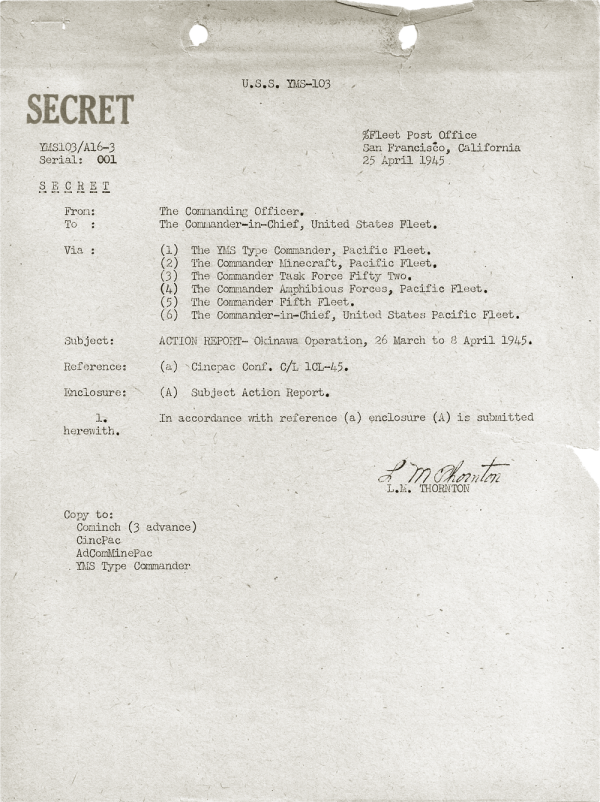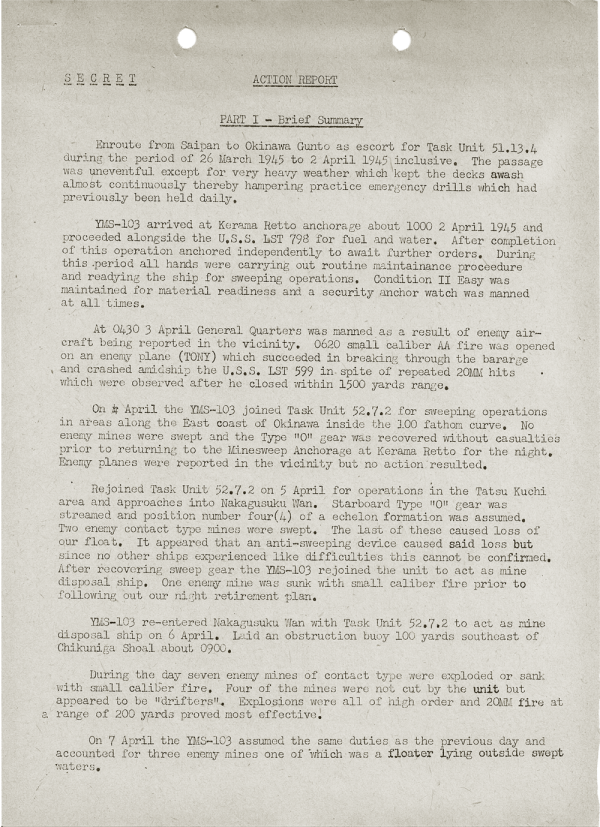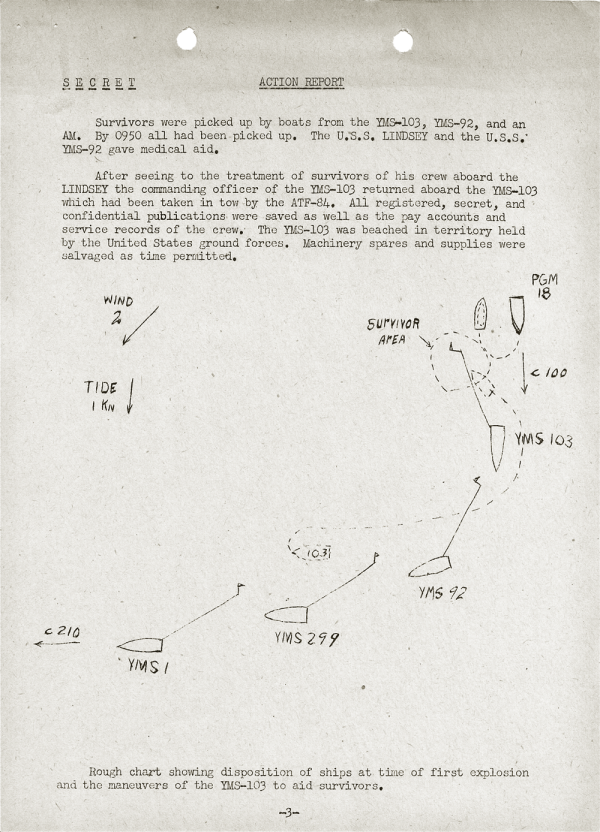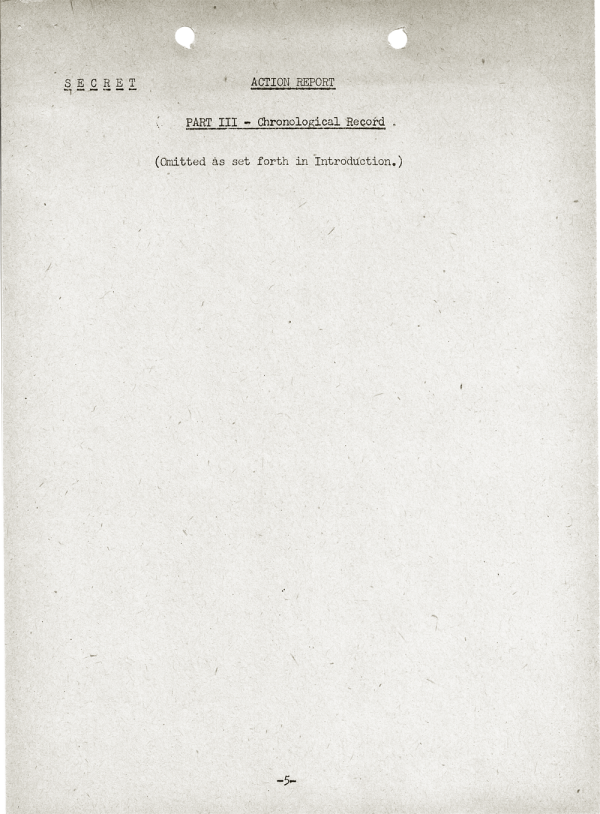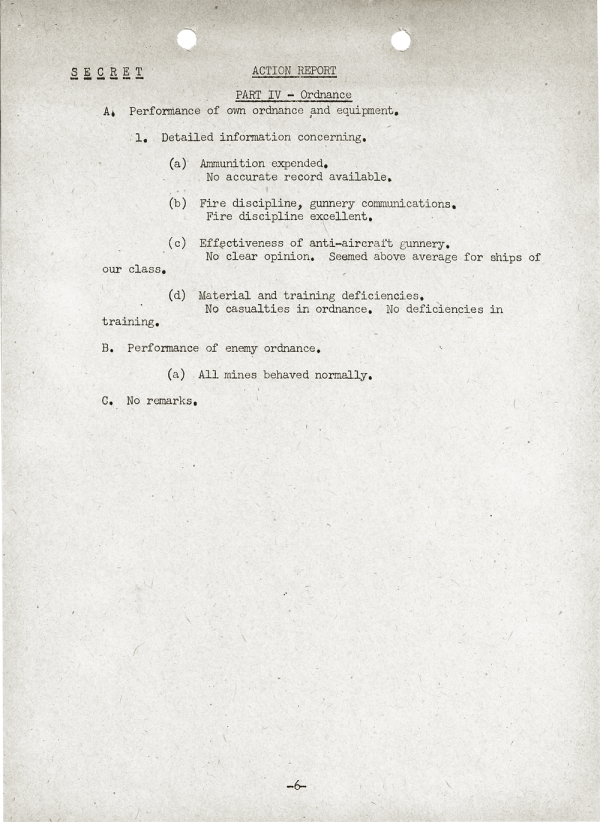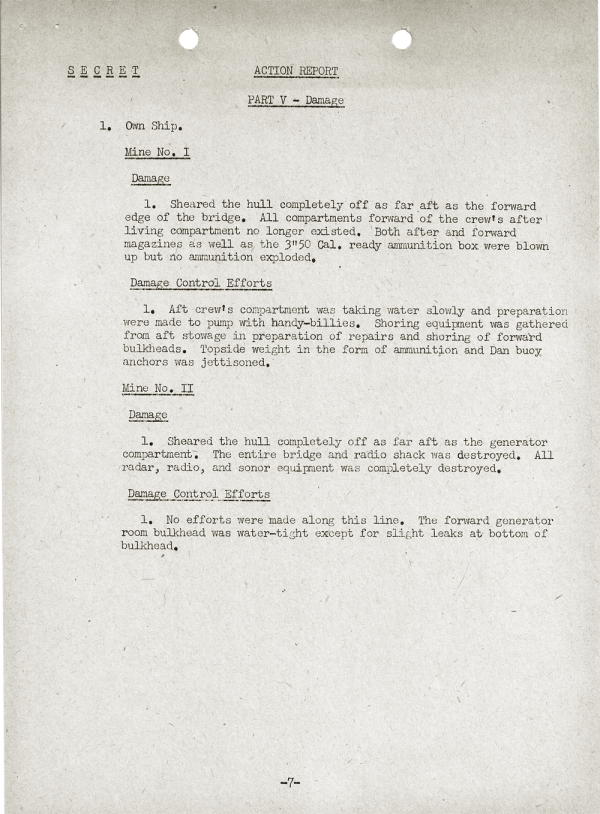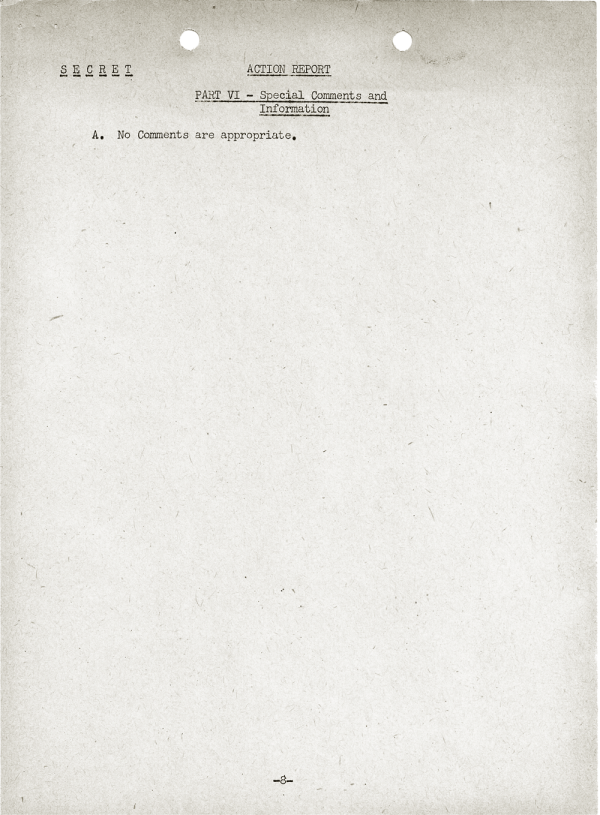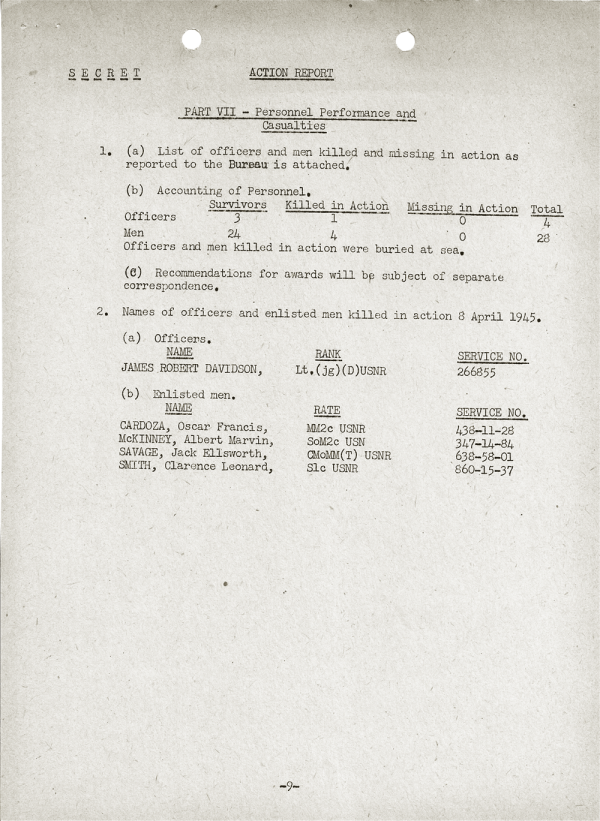I got this action report from Richard Thornton, son of the captain who drafted it. It details the events leading up to the the beaching of YMS-103 in the first month of the Okinawa operations. You’ll see YMS-299 was in the same detail. My grandfather discusses these events in his journal as well.
SECRET
U.S.S. YMS-103YMS103/A16-3
Serial: 001%Fleet Post Office
San Francisco, California
25 April 1945SECRET
From: The Commanding Officer,
To: The Commander-in-Chief, United States Fleet.
Via:(1) The YMS Type Commander, Pacific Fleet.
(2) The Commander Minecraft, Pacific Fleet.
(3) The Commander Task Force Fifty Two.
(4) The Commander Amphibious Forces, Pacific Fleet.
(5) The Commander Fifth Fleet.
(6) The Commander-in-Chief, United States Pacific Fleet.Subject: ACTION REPORT— Okinawa Operation, 26 March to 8 April 1945.
Reference: (a) Cinepac Conf. C/L 1CL-45.
Enclosure: (A) Subject Action Report.
1. In accordance with reference (a) enclosure (A) is submitted herewith.[signed] L M Thornton
L.M. THORNTONCopy to:
Cominch (3 advance)
CinePac
AdComMinePac
YMS Type Commander
U.S.S. YMS-103
SECRET
ACTION REPORTINTRODUCTION
Due to the fact that all logs and communication records of the U.S.S. YMS-103 were lost a strictly chronological account as required in Part III of reference (a) would be inaccurate. Therefore Part I has been expanded to include a complete report which is believed to be basically accurate and of more value in showing clearly the order of events as they occurred, including the rescue and disposal of survivors as well as the salvaging of all confidential and secret publications which was accomplished some time after the U.S.S. YMS-103 was abandoned for safety reasons.
SECRET
ACTION REPORTPART I — Brief Summary
Enroute from Saipan to Okinawa Gunto as escort for Task Unit 51.13.4 during the period of 6 March 1945 to 2 April 1945 inclusive. The passage was uneventful except for very heavy weather which kept the decks awash almost continuously thereby hampering practice emergency drills which had previously been held daily.YMS-103 arrived at Kerama Retto anchorage about 1000 2 April 1945 and proceeded alongside the U.S.S. LST 798 for fuel and water. After completion of this operation anchored independently to await further orders. During this period all hands were carrying out routine maintenance procedure and readying the ship for sweeping operations. Condition II Easy was maintained for material readiness and a security anchor watch was manned at all times.
At 0430 3 April General Quarters was manned as a result of enemy aircraft being reported in the vicinity. 0620 small caliber AA fire was opened on an enemy plane (TONY) which succeeded in breaking through the barrage and crashed amidship the U.S.S. LST 599 in spite of repeated 20MM hits which were observed after he closed within 1500 yards’ range.
On 4 April the YMS-103 joined Task Unit 52.7.2 for sweeping operations in areas along the East coast of Okinawa inside the 100 fathom curve. No enemy mines were swept and the Type “O” gear was recovered without casualties prior to retuning to the Minesweep Anchorage at Kerama Retto for the night. Enemy planes were reported in the vicinity but no action resulted.
Rejoined Task Unit 52.7.2 on 5 April for operations in the Tatsu Kuchi area and approaches into Nakagusuku Wan. Starboard Type “O” gear was streamed and position number four(4) of a echelon formation was assumed. Two enemy contact type mines were swept. The last of these caused loss of our float. It appeared that an anti-sweeping device caused said loss but since no other ships experienced like difficulties this cannot be confirmed. After recovering sweep gear the YMS-103 rejoined the unit to act as mine disposal ship. One enemy mine was sunk with small caliber fire prior to following out our night retirement plan.
YMS-103 reentered Nakagusuku Wan with Task Unit 52.7.2 to act as mine disposal ship on 6 April. Laid an obstruction buoy 100 yards southeast of Chikuniga Shoal about 0900.
During the day seven enemy mines of contact type were exploded or sank with small caliber fire. Four of the mines were not cut by the unit but appeared to be “drifters”. Explosions were all of high order and 20MM fire at a range of 200 yards proved most effective.
On 7 April the YMS-103 assumed the same duties as the previous day and accounted for three enemy mines one of which was a floater lying outside swept waters.
SECRET
ACTION REPORTAbout 1700 the entire unit was taken under fire by enemy installations located 2000 yards from China Saki on bearing of 225[deg] true. The YMS-103 returned fire at a closing range of 6000 yards with the main batteries until ordered by Task Unit Commander to expedite retirement. While retiring the U.S.S. YMS-427 received a direct hit on the port side at frame 90. The YMS-103 was next taken under fire and five straddles were observed close aboard during evasive action. Enemy battery appeared to be about 75MM. Night retirement was carried out as before.
The following day, 8 April 1945, the unit again entered Nakagusuku Wan. The YMS-103 assumed position number four(4) in a starboard echelon formation consisting of the YMS-1(flag), YMS-299, and YMS-92, in that order. Type “O” gear was streamed using 250 fathoms’ scope and a 40-foot pendant. Station distance between ships was 700 yards and the U.S.S. PGM-18 was acting as mine disposal ship 500 yards astern of the formation bearing 10[deg] off the YMS-103 Port quarter.
As the area was entered all water tight hatches were dogged tight and all personnel were above decks wearing life jackets and helmets. About 0743 as the YMS-103 was coming to course 210[deg] true from a course of 100[deg] true an enemy mine exploded under the U.S.S. PMG-18 just at the midships line on the Port side lifting her stern clear of the water. The PGM-18 came down with a 20[deg] starboard list and fire was visible above her decks. It performed a slow 180[deg] turn to the right at the same time rolling completely over to the starboard by 0742. A hole of about 40 square feet in the area and of circular pattern was visible in her bottom.
At 0750 CTG 52.7.2 ordered the YMS-103 to slip sweep gear and return to aid survivors. This operation was carried out with all possible speed. Swept water was reentered and an approach was made to the survivors on a course of 240[deg] true on the upwind side. The degaussing was in operation at all times. 0600 stopped all screws after maneuvering so as to be dead in water with survivors along each side of ship. The first aid station was manned in the galley and crew members were deployed along each rail to aid rescue. The wherry was put overboard to pick up wounded and life lines were being passed to groups of survivors when the PGM sank at 0805. At 0808 an explosion blew the bow off the YMS-103 as far aft as the forward edge of the bridge. Several men on the 3″50 gun platform were blown clear of the ship. One was killed immediately. There were undoubtedly several members of PGM-18 crew killed by the underwater force of the explosion. Although the forward bulkhead of the after living quarters was not water tight the generator compartment was and immediate steps were taken to keep the ship afloat. Topside weight was being jettisoned and a handy-billy was brought into use to pump the after crew’s quarters. At 0813 all depth charges were inspected in preparation of jettisoning then when the second mine sheared the ship as far aft as the generator compartment. This explosion severely injured several men and “Abandon Ship” was ordered as a safety precaution. Dan buoy floats and all life rafts were in the water prior to the second explosion. All men were able to make their way to safe positions. At 0820 the commanding officer left the ship having first inspected all compartments and machinery spaces for possible survivors.
-2-
SECRET
ACTION REPORTSurvivors were picked up by boats from the YMS-103, YMS-92, and an AM. By 0950 all had been picked up. The U.S.S. LINDSEY and the U.S.S. YMS-92 gave medical aid.
After seeing to the treatment of survivors of his crew aboard the LINDSEY the commanding officer of the YMS-103 returned aboard the YMS-103 which had been taken in tow by the ATF-84. All registered, secret, and confidential publications were saved as well as the pay accounts and service records of the crew. The YMS-103 was beached in territory held by the United States ground forces. Machinery spares and supplies were salvaged as time permitted.
[clockwise from top-right]
SURVIVOR AREA
PGM-18
c100
YMS-103
YMS-92
YMS-299
YMS-1
c210
TIDE 1 KN
WIND 2Rough chart showing disposition of ships at time of first explosion and the maneuvers of the YMS-103 to aid survivors.
-3-
SECRET
ACTION REPORTPART II — Preliminaries
A. The U.S.S. YMS-103 was operating as part of the Fifth Fleet (Admiral R.A. SPRUANCE, USN) in Task Force Fifty-One (Vice-Admiral R.K. TURNER, USN) and was further assigned to Task Force 52. Upon arrival at objective it reported to CTG 52.7.2 for sweeping operations under Commander Minecraft, United States Pacific Fleet, where it remained until its destruction.
B. These duties and activities are described in detail in Part I.
C. No remarks.
D. No remarks – covered in Part I.
E. No remarks.
-4-
SECRET
ACTION REPORTPART III — Chronological Record
(Omitted as set forth in Introduction.)
-5-
SECRET
ACTION REPORTPART IV — Ordnance
A. Performance of own ordnance and equipment.
1. Detailed information concerning.
(a) Ammunition expended.
No accurate record available.(b) Fire discipline, gunnery communications.
Fire discipline excellent.(c) Effectiveness of anti-aircraft gunnery.
No clear opinion. Seemed above average for ships of our class.(d) Material and training deficiencies.
No casualties in ordnance. No deficiencies in training.B. Performance of enemy ordnance.
(a) All mines behaved normally.
C. No remarks.
-6-
SECRET
ACTION REPORTPART V — Damage
1. Own ship.
Mine No. I
Damage
1. Sheared the hull completely off as far aft as the forward edge of the bridge. All compartments forward of the crew’s after living compartment no longer existed. Both after and forward magazines as well as the 3″50 Cal. ready ammunition box were blown up but no ammunition exploded.
Damage Control Efforts
1. Aft crew’s compartment was taking water slowly and preparation were made to pump with handy-billies. Shoring equipment was gathered from aft stowage in preparation of repairs and shoring of forward bulkheads. Topside weight in the form of ammunition and Dan buoy anchors was jettisoned.
Mine No. II
Damage
1. Sheared the hull completely off as far aft as the generator compartment. The entire bridge and radio shack was destroyed. All radar, radio, and sonar equipment was completely destroyed.
Damage Control Efforts
1. No efforts were made along this line. The forward generator room bulkhead was water-tight except for slight leaks at bottom of bulkhead.
-7-
SECRET
ACTION REPORTPART VI — Special Comments and Information
A. No comments are appropriate.
-8-
SECRET
ACTION REPORTPART VII — Personnel Performance and Casualties
1.
(a) List of officers and men killed and missing in action as reported to the Bureau is attached.
(b) Accounting of Personnel.
Survivors Killed in Action Missing in Action Total Officers 3 1 0 4 Men 24 4 0 28 Officers and men killed in action were buried at sea.
(c) Recommendations for awards will be subject of separate correspondence.
2. Names of officers and enlisted men killed in action 8 April 1945.
(a) Officers.
NAME RANK SERVICE NO. JAMES ROBERT DAVIDSON, Lt.(jg)(D)USNR 266855 (b) Enlisted men.
NAME RANK SERVICE NO. CARDOZA, Oscar Francis, MM2c USNR 438-11-28 McKINNEY, Albert Marvin, SoM2c USN 347-14-84 SAVAGE, Jack Ellsworth, CMoMM(T) USNR 638-58-01 SMITH, Clarence Leonard, S1c USNR 860-15-37 -9-
SECRET
ACTION REPORTPART VIII — Lessons learned, conclusions, and recommendations
1. The YMS-103 was one of the oldest ships of her type in the Pacific area and was manned by a well trained, confident and experienced crew. As such there was the highest of ship spirit among her officers and crew. The conclusions herein presented are not intended to be at cross purposes with doctrine or procedure but are valuable in that they may present a closer view of small craft problems.
2. Sweeping operations.
A. Better fire support should be given small units when they work in close to beaches in restricted areas. Maneuverability and speed are naturally hampered in sweeping operations.
B. When units have swept areas in bays or anchorages it naturally shows intentions of using same areas at a later date. To prevent possible counter measures under cover of darkness it would be well to post anti-sub patrols across the entrances including as part of their duties that of radar picket to prevent laying of mines by small boats in previously swept areas. Since the U.S.S. PGM-18 was definitely in waters swept by Task Unit 52.7.2 and her degaussing was on, moored contact and magnetic mines are excluded. The second mine which went off under the U.S.S. YMS-103 occurred after all engines and generators were secured. This excludes acoustic mines. The mines were, therefore, either floaters or sub-surface floaters. Since the area had been crossed and recrossed prior to 8 April the mines must have been laid by planes, small surface craft or submarines the night of 7 April 1945.
-10-
